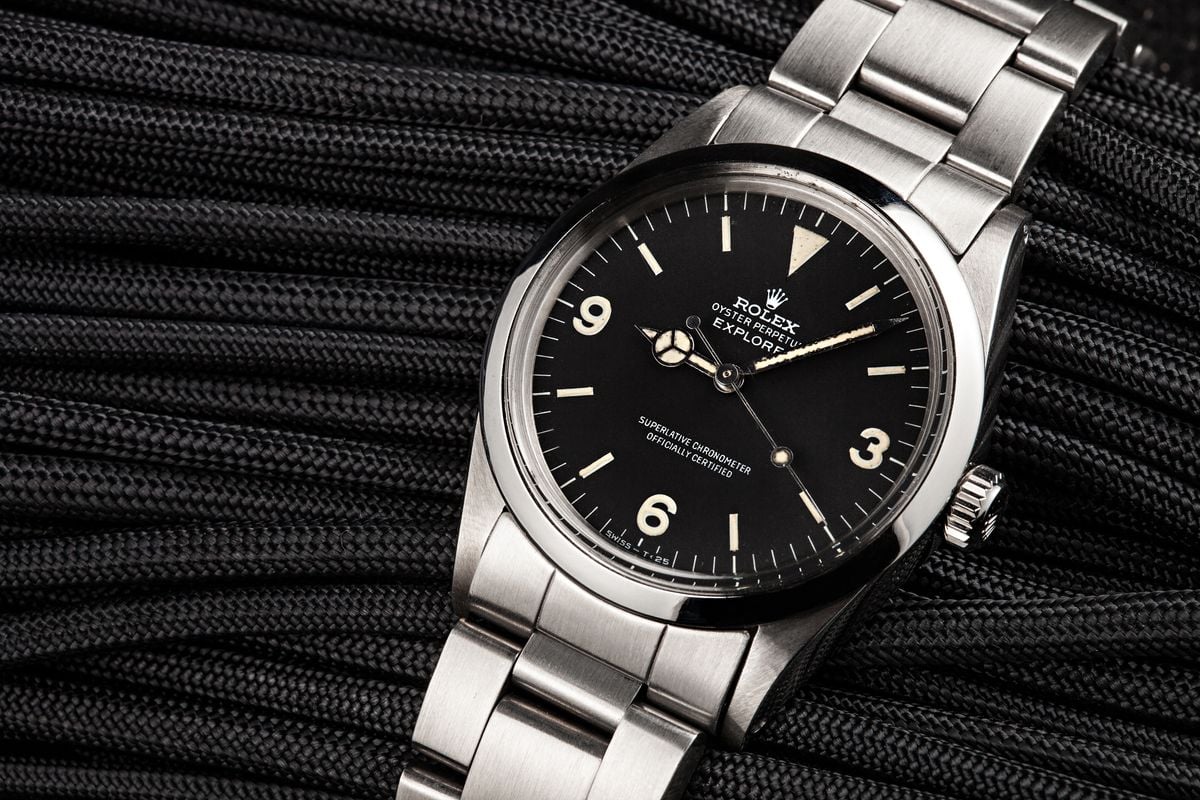A mainstay of the Rolex catalog since the early 1950s, the Explorer is both the brand's oldest sports watch still in production, along with being its most understated. As is the norm for long-running models from the brand's catalog, the Rolex Explorer has undergone some notable modifications over its almost seven-decade history while still retaining its fundamental design characteristics. And it is these modifications that will largely determine which Explorer reference is right for you. So with that in mind, here is everything that you need to know about this collection with our Rolex Explorer ultimate buying guide.
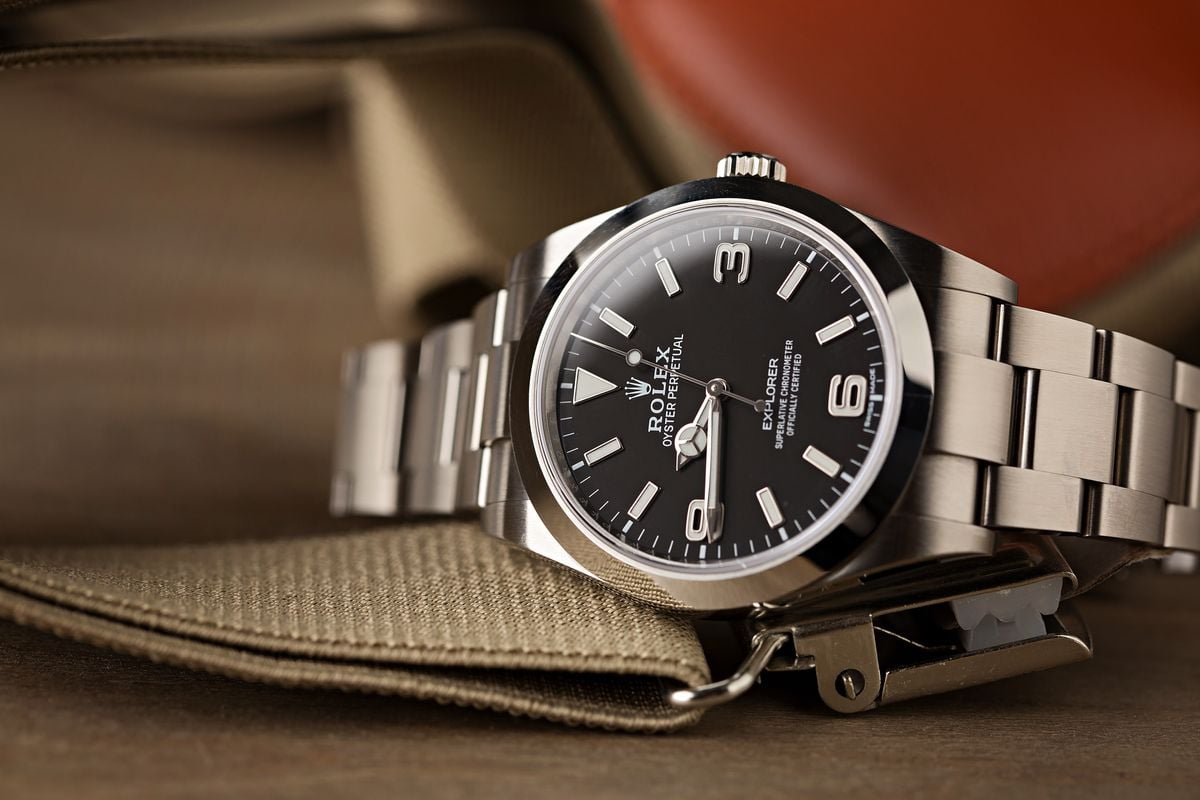
Release Year: 1953
Case diameter: 36mm; 39mm
Materials: Stainless steel
Functions: Time + running seconds
Bezel: Fixed; smooth
Dial: Black; Arabic numerals at 3, 6, and 9
Bracelet: Oyster
Water-Resistance: 50m (pre-1959); 100m (post-1959)
Click here to learn the difference between the Rolex Explorer and the Explorer II.
Led by Colonel John Hunt, the British Mount Everest expedition of 1953 was the ninth attempt at the first ascent of Mount Everest. Rolex had provided members of the expedition with Oyster Perpetual watches - not only as a clever marketing move in anticipation of success but also to test the timepieces out in the real world. On May 29, 1953, Edmund Hillary and Tenzing Norgay made history by becoming the first confirmed to reach the summit.
Naturally, Rolex jumped on the chance to commemorate the historic moment and a few months later, the brand introduced the Explorer watch. Built as a sturdy steel timepiece sporting Rolex's famed water-resistant Oyster case and accurate self-winding Perpetual movement, the Oyster Perpetual Explorer offered exceptional legibility thanks to a stark time-only dial with luminous hands and indices Technically speaking, both the reference 6098 and ref. 6298 could be considered Explorer watches; however, the vast majority feature light-colored dials and are really classified as "Pre-Explorer" Oyster Perpetual models. The first two references of the collection (as we know it today) were the ref. 6150 and the ref. 6350 - however, the ref. 6350 is noted for being the first to actually include the EXPLORER name on the dial with any sort of consistency.
Rolex then unveiled the Explorer ref. 6610, which was shortly replaced by the Explorer ref. 1016. One of the longest-running Rolex references ever made, the Explorer 1016 underwent plenty of modifications during its three-decade production run. The introduction of the ref. 14270 in the late-1980s ushered in the modern era of the Explorer, succeeded by the ref. 114270 at the start of the new millennium. 2010 marked a major shift for the Rolex Explorer as the newest model, the ref. 214270 sported a noticeably larger 39mm case rather than the once-standard 36mm case diameter. Finally, in 2016, Rolex slightly revised the dial and hands of the Explorer but kept the same 214270 reference number.
1953 – Sir Edmund Hillary and Tenzing Norgay reach the summit of Mount Everest
1953 – Rolex introduces the Explorer to commemorate Mount Everest ascent
1953 – “Pre-Explorer” ref. 6150
1953 – Explorer Ref. 6350 is the first Rolex with “Explorer” on the dial
1955 – Rolex introduces Explorer ref. 6610
1959 – Rolex introduces Explorer ref. 1016
1989 – Rolex introduces Explorer ref. 14270
2001 – Rolex introduces Explorer ref. 114270
2010 – Rolex introduces Explorer ref. 214270
2016 – Rolex introduces Explorer ref. 214270 with MKII dial
2021 - Rolex introduces model number 226570
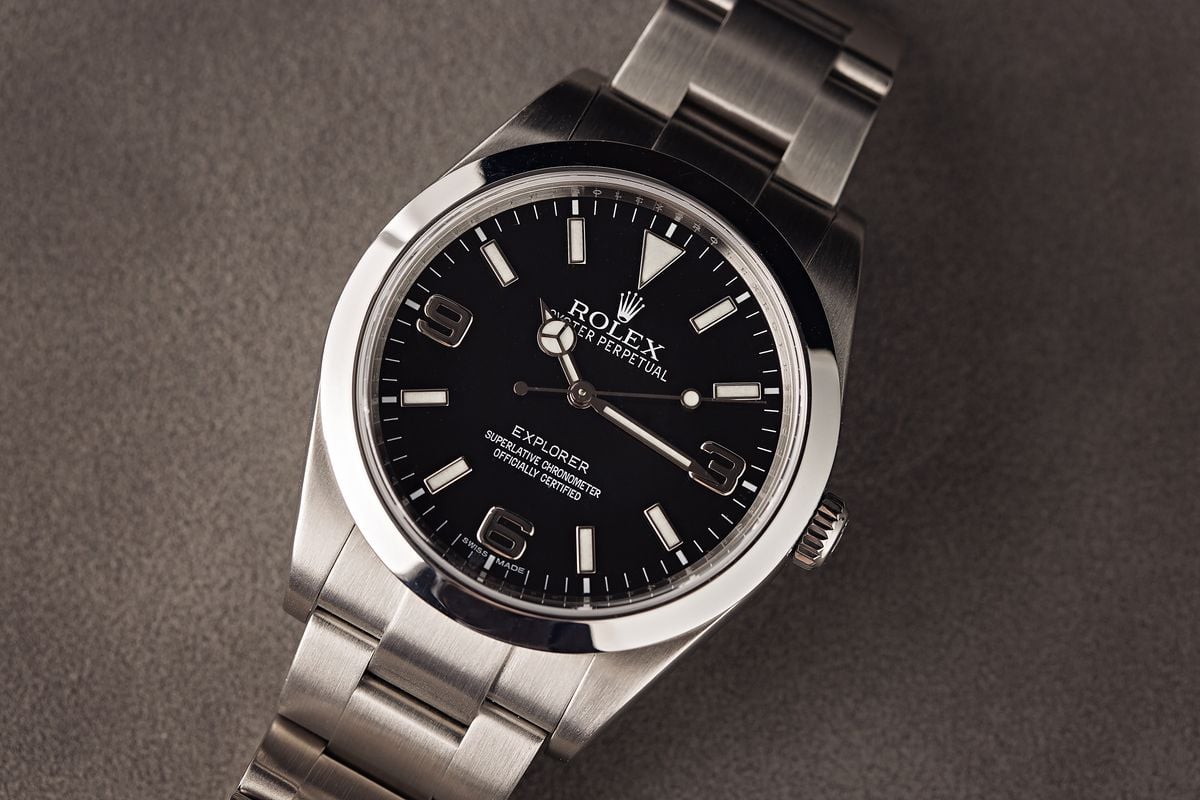
While some Rolex watch collections are varied in terms of material and design choices, the Explorer has (almost) always been a one-reference-at-a-time lineup. From vintage Explorers to the current reference, the watches have always sported stainless steel cases and stainless steel Oyster bracelets. Additionally, with the exception of some ultra-rare examples, Rolex has exclusively furnished its Explorer watches with black time-only dials topped with a mix of luminous baton indexes and Arabic numeral hour markers at the 3, 6, and 9 o'clock locations.
Although the Explorer has always remained consistent in terms of its overall look, Rolex has of course upgraded the watch with updated cases, movements, luminescence, bracelets, and crystals. Even the type of steel used has been improved and the dial execution has steadily been modernized. With that in mind, the biggest design change occurred relatively recently when the Rolex Explorer grew in size.
When the Rolex Explorer made its official debut in 1953, the watch featured a 36mm steel Oyster case to house its now-signature black dial with 3/6/9 numerals. Rolex stuck to those dimensions for the next five-plus decades until 2010, when the brand released the Explorer ref. 214270 with a 39mm case. Therefore, current-production Rolex Explorers have 39mm cases while discontinued and vintage Explorer references have 36mm cases.
- ref. 6150
- ref. 6350
- ref. 6610
- ref. 1016
- ref. 14270
- ref. 114270
- ref. 214270
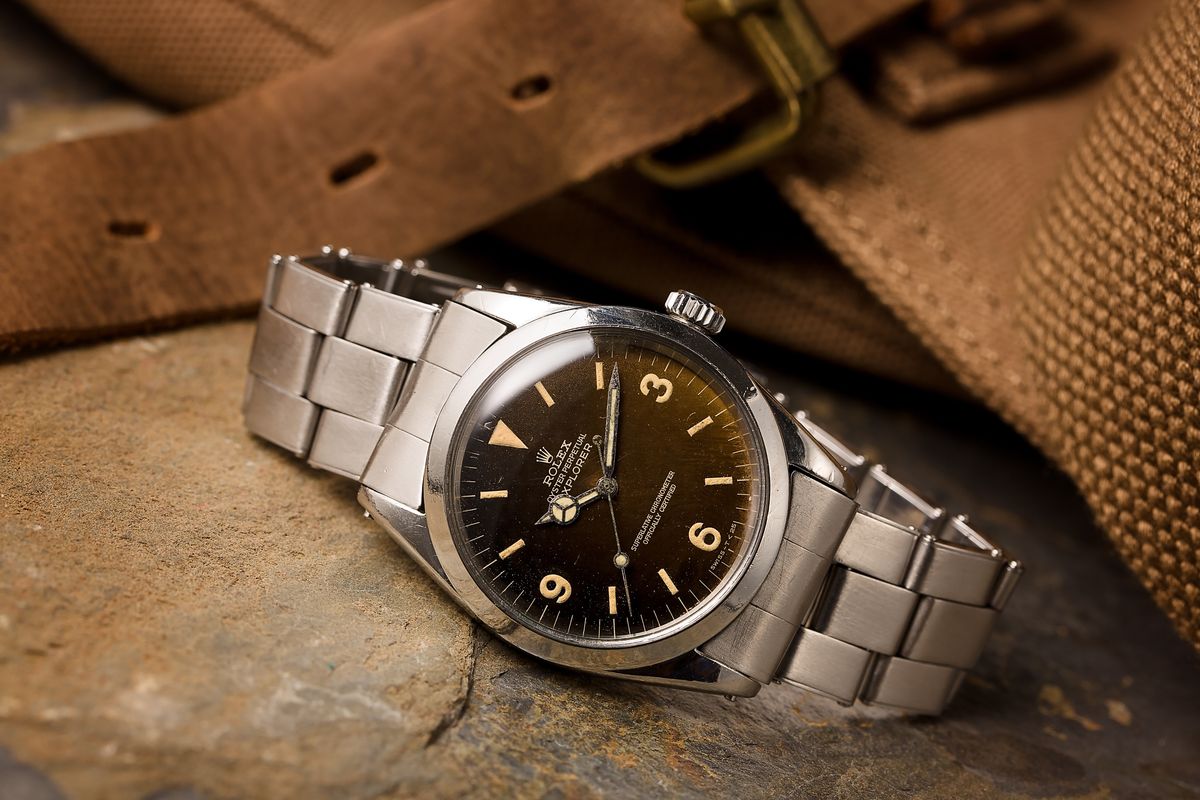
The Oyster Perpetual Explorer is an automatic Rolex watch. Powered by a self-winding "Perpetual" movement encased in a water-resistant Oyster case, the time-only Explorer is one of the simpler Rolex watches in regards to functionality. However, given its adventure-set audience, Rolex has always ensured that the Explorer movement is robust enough to maintain timekeeping accuracy under the most extreme circumstances.
The first two references, the 6150 and 6350, ran on Caliber A296 movements, characterized by a thick rotor for automatic winding. As such, these watches had domed casebacks (better known as the "bubble back" style) to accommodate the protruding rotor. It's worth pointing out that although they had the same calibers, the Explorer ref. 6350 was chronometer-certified while the ref. 6150 was not. A closer look at their dials reveals that the 6150 includes a "Precision" label and the ref. 6350 features the "Officially Certified Chronometer" (OCC) designation.
A few short years later, Rolex unveiled the Explorer ref. 6610, fitted with the chronometer-rated Caliber 1030. Compared to the A296, the Caliber 1030 has a slimmer profile. Therefore, the Explorer 6610 featured a flatter caseback. The movement operated at a frequency of 18,000 beats per hour and included 25 jewels. As Rolex's go-to time-only movement of the era, it powered other no-date models such as the Submariner, Air-King, and Oyster Perpetual.
1959 marked the arrival of the Explorer 1016, equipped with the Caliber 1560. Rolex replaced the Caliber 1560 with the higher-beat (19,800bph) Caliber 1570 around 1965. In 1972, Rolex modified the Caliber 1570 so that the seconds hand came to a complete stop when the winding crown is pulled out, enabling precise time-setting. This feature is commonly known as "hacking seconds" and it has become standard on the majority of modern watch movements.
Along with a modernized design, the Explorer ref. 14270, released in 1989, also housed the then-new Caliber 3000 movement, which beats at a frequency of 28,800bph, includes 27 jewels, and offers a power reserve rating of 48 hours. It wasn't too long before Rolex replaced that movement with the Caliber 3130, which found its way into the Explorer ref. 114270 in 2001. While the Caliber 3000 and 3130 are almost identical, the newer movement included a full balance bridge (instead of a balance cock) and a Breguet overcoil hairspring.
Finally, when Rolex released the current Explorer 214270, it furnished the watch with the Caliber 3132. Designed and built entirely in-house, the Caliber 3132 includes a Parachrom hairspring and Paraflex shock absorbers for improved durability, while retaining the 48-hour power reserve of its predecessor. In 2015, Rolex redefined its Superlative Chronometer Officially Certified movement parameters to guarantee an accuracy rating of -2/+2 seconds per day - twice the precision minimum set out by COSC.
1953 – Caliber A296
1955 – Caliber 1030
1959 – Caliber 1560
1965 – Caliber 1570
1972 – Caliber 1570 – with hacking
1989 – Caliber 3000
2001 – Caliber 3130
2010 – Caliber 3132
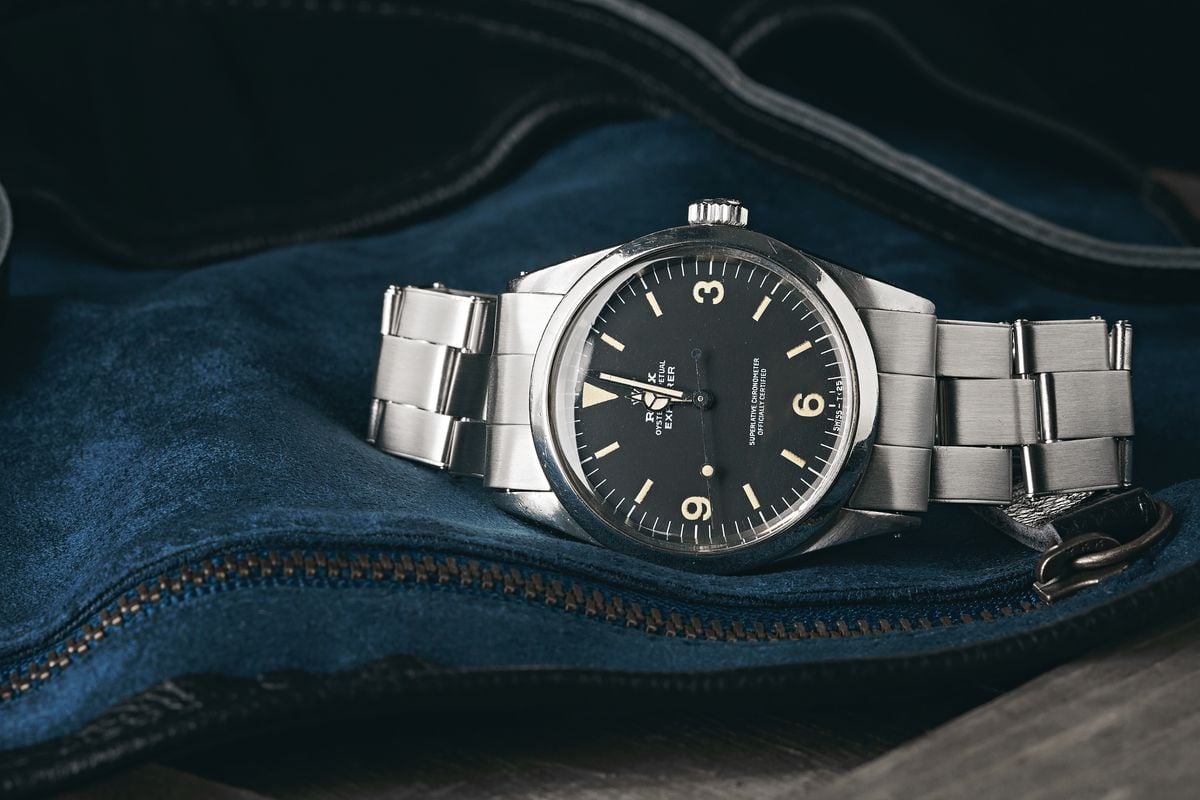
While the Explorer has been Rolex's most constant design, there have been plenty of subtle design tweaks and material improvement throughout the generations. The Explorer's signature look is a black dial with Arabic numerals at 3, 6, and 9 along with an inverted triangle at 12 and batons for the rest of the hours. However, the execution of the dial has evolved over the years.
Early examples of the Explorer had what are known as glossy gilt dials, characterized by shiny black backgrounds, golden-colored writing, and painted on luminous details. Some versions even included a honeycomb pattern, which are highly collectible today. Around the mid-1960s (during the era of the Explorer ref. 1016) Rolex transitioned to matte black dials, white printed text, and retained the painted-on lume plots. With the introduction of the ref. 14270, Rolex redesigned the Explorer dial to include a glossy background with white text and applied white gold hour markers filled with luminescence.
1953 – 1967: Gilt-Gloss Dials
1967 – 1989: Matte Dials with Painted Lume
1989 – Present: Glossy dials with applied white gold hour markers
Another evolution that has occurred on the Explorer is the type of luminous material used. Up until about 1963, luminous radium paint was used on dials for legibility in low light. However, due to the dangers of radium, in 1963 Rolex switched to safer tritium paint, which was also self-luminous and radioactive but to a much lesser degree. Tritium dials are marked with the letter "T" below the 6 o'clock marker. In the mid-1990s (during the era of the Explorer ref. 14270) non-radioactive LumiNova became the go-to material for Rolex This was eventually replaced by Super-LumiNova by the 2000s with the release of the ref. 114270. LumiNova and Super-LumiNova are essentially the same material but sold under different brand names. Finally, the most recent iteration of the Explorer features Rolex's branded Chromalight luminescence, which glows blue in the dark instead of the green hue of LumiNova.
1953 – 1963: Radium ("SWISS" at 6 o'clock)
1963 – 1997: Tritium ("Swiss-T <25" or "T Swiss Made T" or "T SWISS T" at 6 o'clock)
1997 – 2001: LumiNova
2001 – 2010: Super-LumiNova
2010 – Present: Chromalight
The crystal protecting the dials of the Explorer has also been updated over the years. When the Explorer first came out, it included an acrylic crystal. This continued throughout the manufacturing run of the Explorer 1016. The Explorer ref. 14270 was the first to include a sapphire crystal instead of an acrylic one, prized for its ultra-clear and scratch-resistant surface. Rolex has continued to use sapphire crystals on every Explorer reference since.
Acrylic: ref. 6150, 6350, 6610, and 1016
Sapphire: ref. 14270, 114270, and 214270
Even though Rolex has only ever made the Explorer in stainless steel, the type of steel used has also evolved. In 1985, Rolex became the first watchmaker to use 904L stainless steel rather than the industry-standard 316L for its standard-production watches. The Sea-Dweller was the first Rolex watch to feature this particular high-grade steel alloy, which is noted for its high corrosion-resistant capabilities and distinct sheen. Rolex eventually began rolling out 904L steel cases to other models during the ensuing decades and ultimately made bracelets in the same steel alloy. The first Rolex Explorer to feature a 904L stainless steel case and 904L stainless steel bracelet was the ref. 114270. In recent years, Rolex branded the alloy it uses as "Oystersteel" despite still being 904L stainless steel.
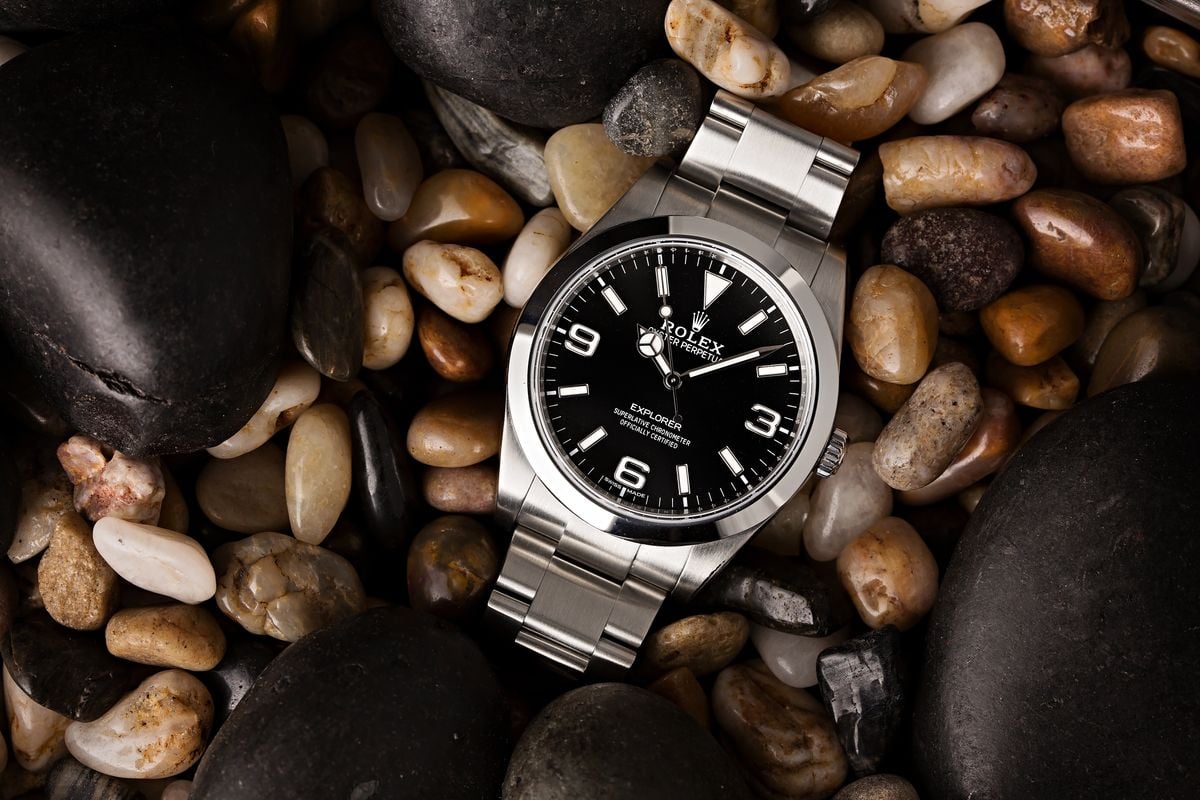
One of the defining characteristics of the Explorer watch is its sporty three-link Oyster bracelet in stainless steel. However, it must be mentioned that if customers wanted their Explorer 1016 watches fitted with the dressier five-link Jubilee bracelets back in the day, Rolex ADs could make that happen. Today it's a different story; Explorer watches always come out of the factory with Oyster bracelets and nothing else.
As with just about every other detail of the Explorer, the Oyster bracelet also evolved over time. Depending on the era, Oyster bracelet links can be riveted (named so for exposed rivets on the side), folded, or solid (as in a smooth surface on the side, not to be confused with solid-filled links). Furthermore, at one point in time, Rolex even offered expandable bracelet links - stretchy bracelets, so to speak. End links (the links that are attached to the case) have also gone from hollow to solid, which are commonly referred to as Solid End Links (SEL). Similarly, the once hollow center links are now entirely solid, giving more heft and durability to the Explorer bracelet. Lastly, the Oyster bracelet clasps have also progressed and today's versions boast a sturdy folding Oysterlock safety clasp fitted with an Easylink 5mm comfort extension link for micro-adjusting on the go.
- ref. 214270: Solid end links, solid center links, milled Oysterlock safety clasp with 5mm Easylink extension system
- ref. 114270: Solid end links, hollow center links, stamped folding clasp
- ref. 14270: Hollow end links, hollow center links, stamped folding clasp
- ref. 1016: Expanding Riveted (introduced in 1954); Non-Expanding Riveted (introduced in 1954); Folded Links (introduced in 1967); Solid Links (introduced in 1975)
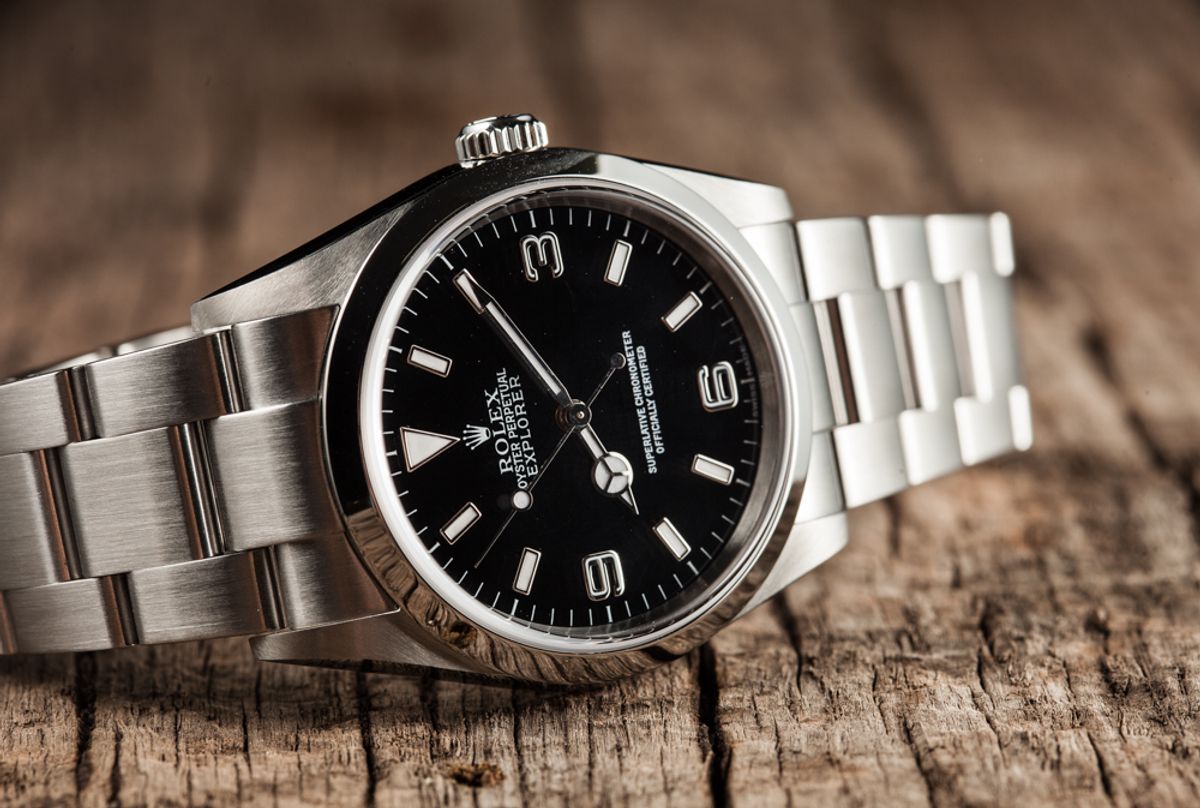
Not including the very first "Pre-Explorer" references but counting the ref. 6150, there have been seven Explorer references to date. Below is a comparison table that outlines the major differences between the references.
| Ref. | Production Years (Approx) | Size and Material | Lume | Crystal | Caliber |
| 6150 | 1953 | 36mm; Stainless Steel | Radium | Acrylic | A296 (Non-chronometer) |
| 6350 | 1953 – 1955 | 36mm; Stainless Steel | Radium | Acrylic | A296 |
| 6610 | 1955 – 1959 | 36mm; Stainless Steel | Radium | Acrylic | 1030 |
| 1016 | 1959 – 1989 | 36mm; Stainless Steel | Radium; Tritium | Acrylic | 1560; 1570 |
| 14270 | 1989 – 2001 | 36mm; Stainless Steel | Tritium; LumiNova | Sapphire | 3000 |
| 114270 | 2001 – 2010 | 36mm; 904L Steel | Super-LumiNova | Sapphire | 3130 |
| 214270 | 2010 – Present | 39mm; 904L Steel Oystersteel | Chromalight | Sapphire | 3132 |
When Rolex unveiled the Explorer ref. 1016 in 1959, the watch brought about a few updates including a new movement protected by a case that offered twice the water resistance (100m) of its predecessor. Thanks to its long production run, the vintage Explorer 1016 model is the most varied of all the Explorer watches. There are early 1016 examples with gilt dials and there are later versions with matte dials. Similarly, the earliest editions of the 1016 still featured radium painted dials, which were replaced with tritium painted ones from 1963 onwards. Depending on the production date, the ref. 1016's Oyster bracelet can differ too, ranging from riveted links to folded links to solid surface links. Inside the case, movements can also differ - the first batches were powered by the Cal. 1560 then the Cal. 1570, followed by the Cal. 1570 with hacking.
Given the various transformations of this particular reference, a vintage Explorer 1016 from the early 1960s is noticeably different (at least to Rolex collectors) from versions of the same reference made during the 1980s. These seemingly subtle differences are some of the reasons why the Explorer 1016 is an exciting model for Rolex enthusiasts to collect. What did remain constant throughout its 30-year production run was its 36mm case size, acrylic crystal, and painted indexes.
If you have your heart on buying a modern 36mm Explorer, then the two newest references are the ref. 14270 (released in 1989) and ref. 114270 (released in 2001). So what are the differences between the Explorer 14270 and the Explorer 114270?
Rolex introduced the Explorer ref. 14270 as the modern replacement for the long-running Explorer ref. 1016. The watch brought about a handful of enhancements, such as sapphire crystal to replace acrylic crystal, applied white gold hour markers to replace painted indexes, a glossy black dial to replace the matte black dial, and the Caliber 3000 to replace the Caliber 1570. Earlier models of the 14270 still used tritium for lume while those from mid-1990s onwards have LumiNova. The numerals on the ref. 14270 are not lume-filled so they will not glow in the dark. There’s also a rare version of the Explorer 14270 made from 1990 - 1991 dubbed the “Blackout” because the 3, 6, and 9 had black paint instead of white paint. The Blackout Explorer is the most collectible modern Explorer in today's market.
When Rolex launched the Explorer ref. 114270, it looked almost identical to the previous reference. But inside the case was a different automatic movement - the Caliber 3130 to replace the Caliber 3000. The only cosmetic changes included the addition of solid end links (SEL) and the use of Super-LumiNova. However, sometime in the mid-2000s, Rolex adopted some counterfeit prevention measures such as engraving the rehaut (the space between the dial and the crystal) and laser etching the crystal with a tiny crown.
Alternatively, if you prefer to buy a 39mm Explorer, then you'll have to look to reference 214270 with the Caliber 3132 movement. However, it's important to know that there are, in fact, two dial versions available within the same Explorer 214270 model, which collectors like to call MK1 and MK2.
The biggest news that came with the introduction of Explorer 214270 was its 39mm case size. Yet, many were quick to remark that the handset of the dial was too short to accommodate the bigger case since the minute hand does not reach the minute track. Some claim that Rolex simply used the same handset from the 36mm Explorer.
Then, in 2016, Rolex presented a revamped version of the Explorer 214270 with a dial that not only included a proportional handset but also luminescent-filled 3, 6, and 9 hour markers. Therefore, the Explorer 214270 MK1 has non-lumed 3/6/9 numerals and a shorter minute hand while Explorer 214270 MK2 has luminous 3/6/9 hour markers and a longer minute hand.
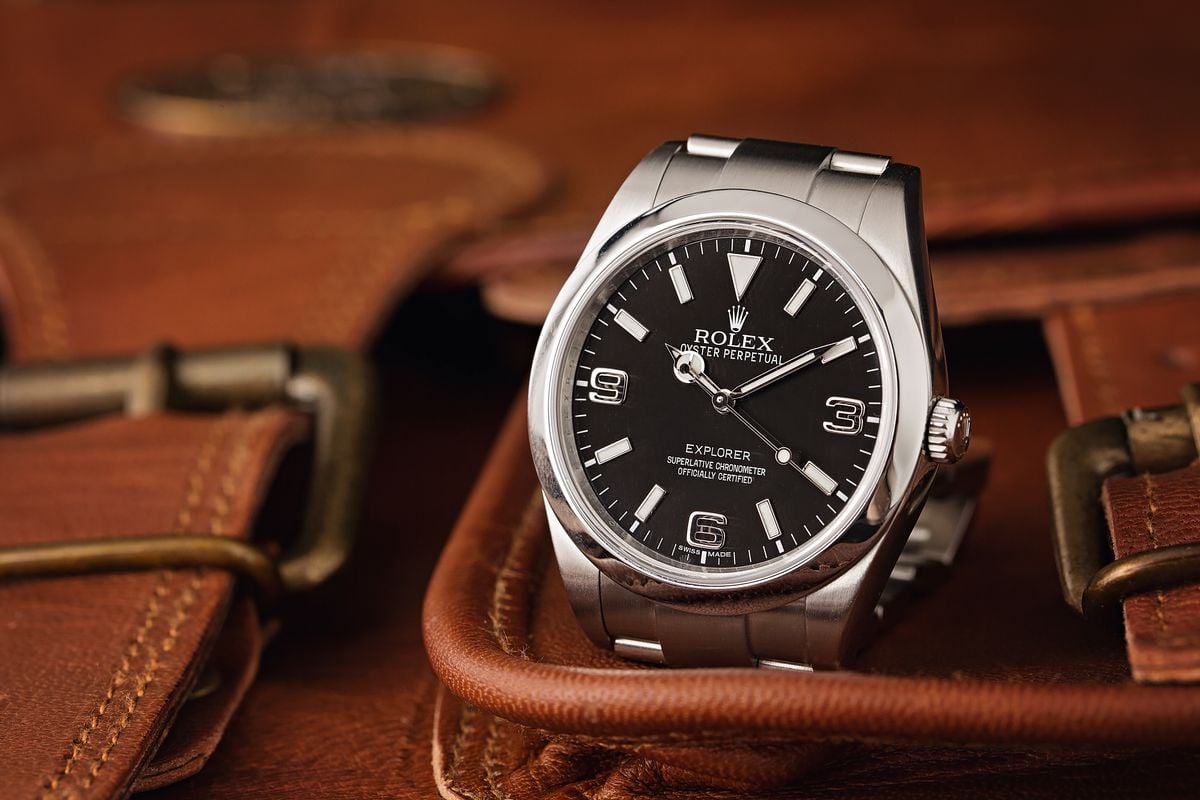
As a stainless steel time-only model, the Explorer has always been one of Rolex's most affordable sports watch models. The Manufacturer Suggested Retail Price (MSRP) of the current-production Rolex Explorer ref. 214270 is $6,550, which is only slightly higher than the steel time-only Air-King's $6,450 price tag and notably less than the stainless steel no-date Submariner's $8,100 retail cost.
Retail Prices of the Explorer and comparable steel time-only Rolex models:
- Explorer ref. 214270 – $6,550
- Air-King ref. ref. 116900 – $6,450
- Submariner ref. 124060 – $8,100
However, similar to many other stainless steel Rolex sports watches, the Explorer is actually valued higher on the secondary market due to demand outpacing supply. Pre-owned Explorer 214270 watches start around $7,195 for the Mark I dial models made from 2010 until 2016. On the other hand, second-hand Explorer models with Mark II dials made from 2016 until the present, typically start at around $7,795. Not too long ago, it was still possible to find the newest iteration of the Explorer for under retail prices on the pre-owned luxury watch market. Yet, the impressive demand for this understated Rolex sports watch has caused its resale value to be higher than its brand-new retail price.
For more affordable used Rolex Explorer watches, the smaller 36mm Explorer ref. 14270 or Explorer ref. 114270 discontinued references are fantastic options. Pre-owned Explorer ref. 14270 models generally start at around $5,195 while secondhand Explorer ref. 114270 examples start at around $5,495. A notable exception to this is the rare and sought-after Explorer ref. 14270 "Blackout" that is valued in the five-figure price range.
Similar to many vintage Rolex watches, vintage Explorer models are highly valued in the collector market. For instance, Explorer ref. 1016 watches start well over $10,000 and prices can jump dramatically for older and/or rare editions. In 2013, Christie's sold an ultra-rare Explorer 6610 with a white "Albino" dial for CHF 171,750 (equivalent to about $160,000).
Whether you decide to go for a 36mm or a 39mm version, MK1 dial or MK2 dial, what you get with all Explorer models is a sturdy stainless steel Rolex sports watch with a classic and discreet design that has endured almost 70 years of history.
